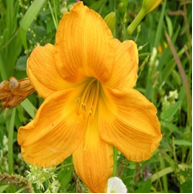BIOLOGICALLY ACTIVE AND SPARE SUBSTANCES THE VEGETATIVE ORGANS OF HEMEROCALLIS HY-BRIDA OF THE BAMDERY CRISMAS VARIETY
UDC 582.573.81:581.134.6
Abstract
In the conditions of the forest-steppe zone of Western Siberia, a comparative study of the content of secondary metabolites, such as pectins, protopectins, catechins, flavonols, sugars, starch, saponins, ascorbic acid in the vegetative organs of Hemerocallis hybrida of the Bambery Crismas variety, was conducted for the first time. Comparative results of the quantitative composition of spare and biologically active substances in leaves and rhizomes during the three growing seasons of 2017–2019 were obtained. The dynamics of accumulation of these substances relative to the phenological phases of plant development of the Bambery Crismas variety is established. It is shown that the highest concentrations of pectin in rhizomes are observed in all years of the study in July during the flowering period (5.26–8.66%). In the leaves, high pectin readings were observed in different phenophases of plant development: in 2017 during the growing season (0.95%), in 2018 during the flowering period (1.59%), in 2019 during the fruiting period (1.27%). The maximum value of flavonols in the leaves (2.2%) during the fruiting period of plants was revealed. The content of saponins in the leaves corresponded to 12.96-32.81%, in the rhizomes 7.79–53.26% in different years of seasonal development and phenophase. The concentration of catechins in leaves is 2–10 times greater than in rhizomes. A high content of ascorbic acid in the leaves (104.7–120.2 mg%) was found. It was noted that the accumulation of starch in the underground organs of plants increased by 1.5 times in the pre-winter period compared to the spring-summer period and amounted to 27.8–48.4%. The analysis showed that the sugar content in the leaves differed depending on the growing season, but it was 2-8 times higher compared to the leaves. Indications of secondary metabolites in the organs of Bambery Crismas differ in specificity, depend on the growing seasons and phenological phases of the development of plants of this variety.
Downloads
Metrics
References
Sedel'nikova L.L. Vestnik KGAU, 2017, no. 10, pp. 114–120. (in Russ.).
Zhapova O.I. Ekologo-fitotsenoticheskaya priurochennost' Hemerocallis minor Miller i nakopleniye v nem bio-logicheski aktivnykh veshchestv (Zabaykal'ye): avtoref. dis. ... kand. biol. nauk. [Ecological and phytocenotic confine-ment of Hemerocallis minor Miller and the accumulation of biologically active substances in it (Transbaikalia): author. dis. ... cand. biol. Sciences]. Chita, 2006, 19 p. (in Russ.).
Reut A.A. Izvestiya Federal'nogo nauchnogo tsentra ovoshchevodstva, 2019, no. 1, pp. 93–96. (in Russ.).
Chuparina Ye.V., Martynov A.M., Zhapova O.M. Sibirskiy meditsinskiy zhurnal, 2008, no. 3, pp. 98–99. (in Russ.).
Tsitsilin A.N. Lekarstvennyye rasteniya na dache i vokrug nas: polnaya entsiklopediya. [Medicinal plants in the coun-try and around us: a complete encyclopedia]. Moscow, 2014, 336 p. (in Russ.).
Lekarstvennyye rasteniya Sibiri dlya lecheniya serdechno-sosudistykh zabolevaniy. [Medicinal plants of Siberia for the treatment of cardiovascular diseases]. Novosibirsk, 1991, 260 p. (in Russ.).
Sedel'nikova L.L., Kukushkina T.A. Khimiya rastitel'nogo syr'ya, 2014, no. 1, pp. 177–183. DOI: 10.14258/jcprm.1401177. (in Russ.).
Marchishin S.M., Zarichanskaya Ye.V., Garnyk M.S., Yushchenko T.I. Meditsina i obrazovaniye v Sibiri, 2015, no. 6, pp. 46–55. (in Russ.).
Sedel'nikova L.L., Kukushkina T.A., Cheltygmasheva L.R. Vestnik VorGAU, 2018, vol. 11, no. 2 (57), pp. 20–27. DOI: 10.17238/issn2071-2243.2018.2.20. (in Russ.).
Sedel'nikova L.L., Chankina O.V. Khimiya rastitel'nogo syr'ya, 2020, no. 1, pp. 245–250. DOI: 10.14258/jcprm.20200014612. (in Russ.).
Cichewicz R.H., Nai M.G. J. Agric. Food Chem., 2002, vol. 50, pp. 87–91.
Chuparina E.V., Aiskeva T.S. Environ. Chem. Letters, 2011, vol. 9, no. 1, pp. 19–23. DOI: 10.1007/s10311-009-0240-z.
Clifford M.N., Wu W., Kuhnert N. Food Chem., 2006, vol. 95, pp. 574–578.
Sedel'nikova L.L., Chankina O.V. Chemistry for sustainable development, 2019, vol. 27, pp. 530–535. DOI: 10.15372/CSD2019170.
Belikov V.V. Farmatsiya, 1970, no. 1, pp. 66–72. (in Russ.).
Borodova V. Metodicheskiye ukazaniya po khimiko-tekhnologicheskomu sortoispytaniyu ovoshchnykh, plodovykh i yagodnykh kul'tur dlya konservnoy promyshlennosti. [Guidelines for chemical-technological variety testing of vegeta-ble, fruit and berry crops for the canning industry]. Moscow, 1993, 108 p. (in Russ.).
Kiseleva A.V., Volkhonskaya T.A., Kiselev V.Ye. Biologicheski aktivnyye veshchestva lekarstvennykh rasteniy Yuzhnoy Sibiri. [Biologically active substances of medicinal plants of Southern Siberia]. Novosibirsk, 1991, 135 p. (in Russ.).
Yermakov A.I. Metody biokhimicheskogo issledovaniya rasteniy. [Methods of biochemical research of plants]. Leningrad, 1987, 430 p. (in Russ.).
Kriventsov V.I. Sbornik nauchnykh trudov Gosudarstvennogo Nikitskogo botanicheskogo sada. [Collection of scien-tific works of the State Nikitsky Botanical Garden]. Yalta, 1989, vol. 109, pp. 128–137. (in Russ.).
Kukushkina T.A., Zykov A.A., Obukhova L.A. Aktual'nyye problemy sozdaniya novykh lekarstvennykh preparatov prirodnogo prois-khozhdeniya: materialy VII mezhdunarodnogo s"yezda. [Actual problems of creating new drugs of natural origin: materials of the VII International Congress]. St.-Petersburg, 2003, pp. 64–69. (in Russ.).

Copyright (c) 2022 chemistry of plant raw material

This work is licensed under a Creative Commons Attribution 4.0 International License.

This work is licensed under a Creative Commons Attribution 4.0 International License.
The authors, which are published in this journal, agree to the following conditions:
1. Authors retain the copyright to the work and transfer to the journal the right of the first publication along with the work, at the same time licensing it under the terms of the Creative Commons Attribution License, which allows others to distribute this work with the obligatory indication of the authorship of this work and a link to the original publication in this journal .
2. The authors retain the right to enter into separate, additional contractual agreements for the non-exclusive distribution of the version of the work published by this journal (for example, to place it in the university depository or to publish it in a book), with reference to the original publication in this journal.
3. Authors are allowed to post their work on the Internet (for example, in a university repository or on their personal website) before and during the review process of this journal, as this may lead to a productive discussion, as well as more links to this published work.











